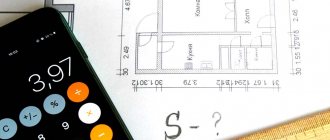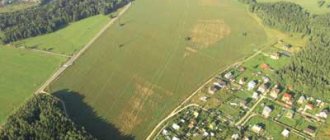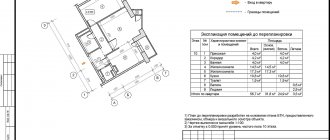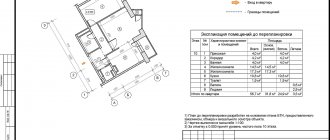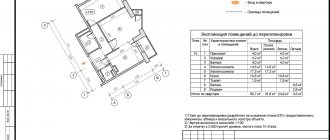Today, all real estate that has undergone the registration procedure in Rosreestr must have a cadastral number - a unique digital identifier that is not repeated over time and throughout the country. But this was not always the case, namely, in addition to cadastral numbers, there were also conditional ones. Such metamorphoses still mislead many people, so it is extremely important for property owners to get an answer to the question: “the difference between a cadastral number and a conditional number, what is the difference?”
What is the cadastral number of a property?
In our country, all real estate properties must be registered in Rosreestr. This accounting procedure is a kind of confirmation on the part of the state of the fact of the existence of objects within the legal framework, about which the corresponding notes are made in the Unified State Register of Real Estate (hereinafter referred to as “USRN”). When entering information about objects into the Unified State Register, for identification purposes, they are assigned unique digital codes, namely cadastral numbers , which act as the main characteristics of the objects and are subsequently indicated in: certificates, extracts from the Unified State Register, tax documents, sales contracts, etc. .d.
A cadastral number is not an arbitrary set of numbers and symbols; in order to determine it and assign it to each property, Rosreestr carries out a cadastral division of our entire country.
Similarities between conditional and cadastral numbers
- Both the conditional and cadastral numbers of real estate are unique. There are no objects with exactly the same numbers.
- The numbers in both numbers are not in random order, but hide certain information behind them, which makes the cadastral and conditional numbers a kind of code that can be easily solved.
- Both numerical codes are assigned only by an authorized organization - the Federal State Registration Service and its division the Cadastral Chamber.
- The cadastral or conditional number is an important identifying characteristic of real estate and is required to be indicated in all documents confirming the owner’s rights.
What does the cadastral number of a property consist of and how is it formed?
The territory of Russia is divided into cadastral districts, which are divided into districts, which in turn are divided into blocks, within the boundaries of which real estate objects are located. All units of cadastral division are assigned registration numbers and names.
So, a cadastral number is a set of registration numbers of cadastral division units and the serial number of an object, separated by colons.
Let's look at a specific example to visualize the structure of a cadastral number. So, a plot of land located at the address: Moscow region, g.o.g. Podolsk, st. Kirova, 4 has a cadastral number 50:55:0030221:3 where: 50 is the number of the cadastral district, in our case it is the Moscow region; 55 – the number of the cadastral district in the district, namely the city. Podolsk; 0030221 – number of the cadastral quarter in the district; But 3 is the direct serial number of the plot in the cadastral quarter. By the way, if a property is removed from the cadastral register, its cadastral number cannot be transferred to another property, i.e. its reuse is excluded.
Property identification
Each piece of property (house, apartment, plot of land) must have a unique code, which is required for its identification.
ATTENTION! The number does not change during planning or reconstruction of the building, as well as its transfer to a new owner.
When registering real estate, the State Property Committee is assigned and a passport is issued (extract from the cadastral register of data). It contains all the information about the property, its purpose, as well as the owner.
There is no validity period for this document. Over time, the data is periodically updated as a result of actions taken with the property. In this connection, information about the object can be requested by both citizens and legal entities.
What is a property reference number?
For objective reasons, real estate accounting has always been carried out, although at different times in different ways, and in different ways even for different types of objects. So, with the advent of privatization in our country and the new land legislation being published, the need arose to identify plots using cadastral numbers. In turn, capital construction projects (buildings, structures, structures) were assigned so-called conditional numbers . Due to the extremely unfinished land legislation (new amendments and regulations are still issued every year), over time, a law on real estate registration appears, which defined and formed a new accounting procedure. Subsequently, the conventional numbers of capital construction projects were abolished and replaced by cadastral numbers, which were more structured and consistent in their formation. At the moment, conditional numbers can be assigned to land plots only on location diagrams and territory surveying projects, in the process of forming such plots.
One property should not have two unique numbers
Property owners who have paper certificates of ownership of houses, apartments and land plots often worry about the number series indicated on the title page. Its format does not correspond to the format of a modern cadastral number. Therefore, citizens have doubts about this cipher, which looks like a long and incomprehensible code. What it is?
The numbers given in the certificate of ownership with delimiters in the form of slashes and hyphens represent the conditional number of the property (UNON).
Owners are interested in the following questions:
- Is this UNON currently valid?
- What should be indicated in the property description - cadastral or conditional number?
- What is the difference between the two No.?
- Is it possible to obtain an extract from Rosreestr using UNON?
- How to decipher the digital series of a conditional number?
Owners have nothing to worry about: old certificates and the numbers indicated in them remain valid, although UNON has lost its legal significance.
Conditional number of a property - what is it?
Until 2000, real estate properties were assigned so-called conditional numbers. On their basis, real estate accounting was carried out. In old certificates issued before the millennium, they are indicated.
UNON coincides with the certificate number, and, like the cadastral one, is a unique characteristic of a real estate property.
The presence of an old number only confirms that the registration of property rights took place in the last century.
The reform of the state cadastre led to the fact that in the early 2000s all UNONs were officially replaced by cadastral numbers of real estate objects (KNON). At the same time, the assignment of new KNONs took place according to different standards.
But since the old certificates of ownership with conventional codes continue to be valid, UNON has not been de facto cancelled: they are taken into account in the information system. Although de jure they no longer exist (renamed). So it turned out that objects may have a cadastral or conditional number that have parallel circulation.
But in the state cadastral registration authority, one property can only have one number. (Two is nonsense).
What is the difference between a cadastral number and a conditional number?
Currently, all information about real estate, including land plots, is located in a single information database - the Unified State Register of Real Estate (USRE), which was formed in 2021 as a result of the merger of the state cadastre with the Unified State Register of Real Estate.
- EGRN is the only body that today maintains real estate records and registration of rights. The unique cadastral number has important legal significance and is used in all real estate transactions.
- The conditional cipher today has retained only an informational meaning: knowing it, you can find KNON (through a search by conditional number), and then take an extract about the object from the Unified State Register of Real Estate.
Fundamental differences between UNON and KNON
Differ:
- principle of education No.;
- format for recording numbers and their decoding in both no.
The first two groups of UNON numbers allow you to determine the geographical location of the object and registration.
An important feature of the cadastral number is that it systematizes a given object according to its position on the cadastral map, within the cadastral districts (CD), cad. districts (KR) and cad. quarters (QC).
An unimportant difference: both numbers differ in length (the conventional one is longer).
Cadastral number structure
KNON looks like a number series of four groups separated by colons:
- the first two two-digit numbers are KO and KR;
- the third number of six to seven digits is KK;
- fourth - serial number of the property.
The serial cadastral number differs from the conditional one in that it reflects the addition of an object to the cadastral territory, and not to the accounting register.
The cadastral number exists for all modern real estate objects, while the conditional number is preserved for those that were registered long ago.
If the owner simply does not know his KNON, this does not mean that it does not exist.
It’s just that this person has not applied to the registry for a long time to receive an extract with detailed information about his property. But it happens that sometimes UNON is also unknown.
How to find out the conditional number of an object
If the owner has a certificate, then you can find UNON in it.
But if the certificate is lost and you have not found the conditional code, then there is no point in looking for it. In order to check the latest information about a building, premises, or land, it will be enough to indicate other data, for example, the address of this object. And at the exact address you can find out the cadastral number
How to find out the cadastral number
There are several search methods.
- You can find KNON through the USRN online service: a search is carried out using a conditional number (this is where its real benefit is).
- At the address of the property, ordering an extract from the Unified State Register of Real Estate.
- Use a cadastral map (to search for land plots): You need to highlight the subject of the Russian Federation of interest on the map.
- A multi-page list of land plots will open with detailed information: cadastral number, address, quarter, status, cadastral number. cost, area, etc.
- From the map, you can determine through the drop-down list (by clicking on the arrow in the Area field) boundaries, districts, districts, OKS, territorial zones, etc.
Example of information on a cadastral map
Plot with cadastral no. 42:30:0225027:32
- 42 - Kemerovo region. (cadastral district);
- 30 - Novokuznetsk (cad. district);
- 0225027 - cadastral quarter;
- 32 — land plot number;
- address: st. Varshavskaya, 129;
- category of lands - lands of settlements;
- cadastral value - 559958 rubles.
- specified area - 1645 sq. m;
- VRI - individual housing construction;
- cadastral engineer - Babenko O.A.
- date of registration: 09/21/2005;
The difference between a cadastral number and a conditional number, what is the difference?
Visually, it is very easy to distinguish a conditional number from a cadastral number: for example, colons serve as separators for digital codes in cadastral numbers, and in conditional ones - a slash (slash) and a hyphen. The rules for assigning (forming) these identifiers are also different: if the cadastral number reflects the cadastral division of the country, then the conditional one was formed on the basis of:
- numbers of the subject of the Russian Federation;
- three-digit number of the subdivision of the territorial body (which made the decision on registration);
- the year in which the registration was recorded;
- and the serial number of such a record was indicated through a hyphen.
Moreover, for capital construction projects, the conditional number, as a rule, coincides with the registration record number.
Today, due to the merger of three services (registration, cadastre and BTI) into one (Rosreestr), absolutely all real estate objects, information about which is entered into Rosreestr, are assigned cadastral numbers. And despite the fact that new conditional numbers are no longer formed, those previously assigned have not lost their legal force and information about them is still stored in the Unified State Register of Real Estate.
Instructions for obtaining new identifiers
Necessary package of documents for registration of a new cadastral code:
- A statement confirming the termination of ownership of a previously existing property.
- A document proving the fact of redevelopment of the land plot. If a large-scale change is planned within the territory, then permission from local authorities is required.
- Applicant's valid passport.
- Receipt for payment of state duty.
A property undergoing renovation does not have a final code. Only after the changes have been completed can a new digital set be assigned.
It is also worth remembering that during the reconstruction stage there is no right to transfer the object to third parties or conduct any other transactions.

